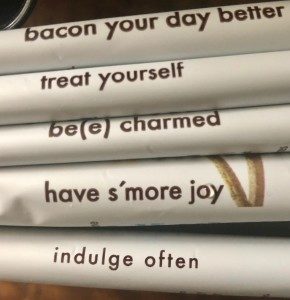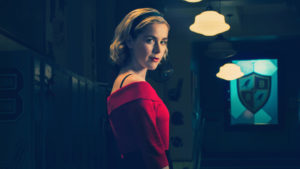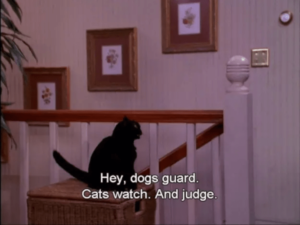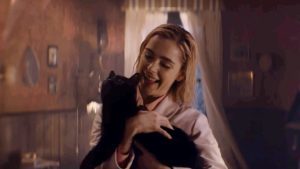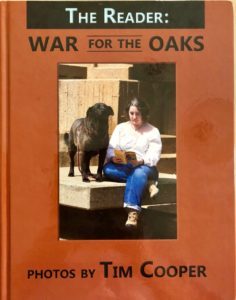Cat Rambo's Blog, page 27
November 30, 2018
Recent Reading: Wolves, Wives, Knives, Curses, A Hospital, and a Henchgirl
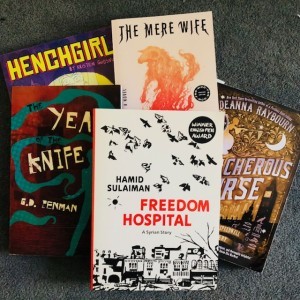 The works read but yet to be reviewed are piling up, so here’s a new roundup to clear away part of the deluge.
The works read but yet to be reviewed are piling up, so here’s a new roundup to clear away part of the deluge.
The Mere Wife by Maria Dahvana Headley is a retelling of Beowulf from the monster’s point of view, set in a possibly not-so-future world where the rich live in protected enclaves. Stark and beautifully told, the story raises the question of who the actual monsters are and whether they haven’t been residing in us all along. (Farrar, Straus and Giroux; release date 17 July 2018)
A Treacherous Curse by Deanna Raybourn is the second in what feels very much like a series, following A Perilous Undertaking. It reads a lot like Elizabeth Peters’ Amelia Peabody series but with a much more sexually outspoken protagonist named Veronica Speedwell and a dose of fantasy. I initially thought Speedwell’s love interest was Bram Stoker, which actually turned out not to be the case. A fun, light read. (Berkeley Original, 2018)
The Year of the Knife by G.D. Penman is entertaining urban fantasy in the police procedural tradition, and will remind the reader of a Ben Aaronovitch novel with a slightly smaller cast. Meerkat has been putting out some very solid stuff, and this is another example of that. (Meerkat Press, 2017)
Two graphic novels, very different from each other, round out the list. The first is Freedom Hospital: A Syrian Story by Hamid Sulaiman, winner of the English PEN Award. This book is graphic, a brutal and heart-wrenching introduction to conditions in Syria in 2012. The art is simple, sometimes with the quality of a slogan stenciled on a wall: I could image image after image from the book used in that way. Recommended but not light reading. (Interlink Publishing Inc., 2018 American Edition)
Henchgirl, by Kristen Gudsnuk, comes from Dark Horse Books and is a fun exploration of the economics of supervillainy, particularly for the minions and henchfolk just trying to make an honest living. Clear and charming drawing with a nice sense of whimsy. (Dark Horse Books, 2017)
You can read this at http://thegreenmanreview.com/books/recent-reading-wolves-wives-knives-curses-a-hospital-and-a-henchgirl/
November 29, 2018
Round-up of Awards Posts by F&SF Writers, Editors, and Publishers for 2018
 It’s that season again! Here’s a collection of awards-eligibility posts from fantasy and science fiction authors and publishing peeps:
It’s that season again! Here’s a collection of awards-eligibility posts from fantasy and science fiction authors and publishing peeps:
Writers:
G.V. Anderson
Elly Bangs
Rachel Beck
Beth Bernobich
Beth Cato
Stephanie Charette
Joyce Chng
Marc A. Criley
Brandon Crilly
Raymond Daley
Karl Dandenell
J.R. Dawson
Matt Dovey
Nicky Drayden
Scott Edelman
Stephanie Feldman
Vanessa Fogg
Susan Forest
R.S.A. Garcia
Jasmine Glower
A.T. Greenblatt
Sean Grigsby
Amy Griswold
Maria Haskins
Kat Heartfield
Joa Heijndermans
Jordan Kurella
L.D. Lewis
Tonya Liburd
Catherine Lundoff
Joseph Malik
Keith Manuel
Arkady Martine
Matt Maxwell
K.C. Mead-Brewer
Premee Mohamed
Aidan Moher
L.H. Moore
Diane Morrison
Wendy Nikel
Julia Novakova
L’Erin Ogle
Chimedum Ohaegbu
Finbarr O’Reilly
Charles Payseur
Adam Rakunas
Jenny Rae Rappaport
Matthew Reardon
Jennifer Lee Rossman
Frances Rowat
Alexandra Rowland
A. Merc Rustad
Amman Sabet
Jason Sanford
John Schoffstall
Effie Seiberg
Hayley Stone
Steve Toase
E. Catherine Tobler
Joseph Tomaras
Patrick S. Tomlinson
Evgenia Triantafylloy
Monica Valentinelli
Sabrina Vourvoulias
Wren Wallis
LaShawn Wanak
Izzy Wasserstein
M. Darusha Wehm
Fran Wilde
A.C. Wise
John Wiswell
James Worrad
Editors:
Magazines:
Apex Magazine
Apparition Lit
Fiyah Magazine
The Gallery of Curiosities
Inklings Press
November 25, 2018
CyberMonday Coupons for the Rambo Academy for Wayward Writers
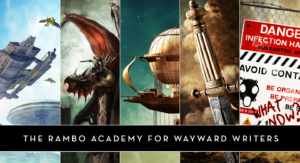 If you’re gift-buying, be aware you can gift one of my classes, both live and on-demand ones! Just drop me a line about what you’d like to do and I’m happy to send the gift certificate in virtual or physical form! Order before Tuesday, November 27th, when I’m back at home to fill the first batch of orders, and I’ll give you an extra 10% off. Check the link below to see what’s available!
If you’re gift-buying, be aware you can gift one of my classes, both live and on-demand ones! Just drop me a line about what you’d like to do and I’m happy to send the gift certificate in virtual or physical form! Order before Tuesday, November 27th, when I’m back at home to fill the first batch of orders, and I’ll give you an extra 10% off. Check the link below to see what’s available!
Live classes
On-demand classes
And if you want something for yourself, here’s some 25% off coupons for the on-demand classes:
Writing Steampunk and Weird Western
Literary Techniques for Genre Writers
Moving from Idea to Finished Draft
Make sure you’ve entered the November giveaway!
The November giveaway is TWO coaching sessions. Use them both yourself, or give one away to a friend. To enter, mail me with the subject line: November 2018 Giveaway by midnight, November 30, 2018.
To the NaNoWriMoers – you’ve got a week left and I’m cheering for you! Go go go!
November 23, 2018
Pilot’s Varsity Disposable Fountain-Pens
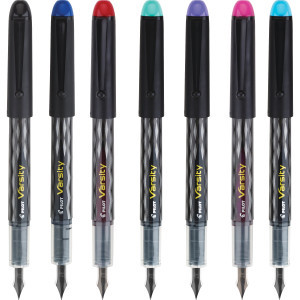 I do a good bit of writing by hand, usually in a large hardbound sketchbook, although I sometimes like the feel of a nice narrow yellow-lined pad or the sprawl of an enormous expanse of drawing paper. And to write on these, while sometimes I’ll wander over into glitter gel pens or fine-point felt tips, my favorite is the Pilot Varsity disposable fountain pen.
I do a good bit of writing by hand, usually in a large hardbound sketchbook, although I sometimes like the feel of a nice narrow yellow-lined pad or the sprawl of an enormous expanse of drawing paper. And to write on these, while sometimes I’ll wander over into glitter gel pens or fine-point felt tips, my favorite is the Pilot Varsity disposable fountain pen.
Depending on where you’re getting it, the price varies from $3-10, with the high range of that usually appearing in fancy stores aimed at writers, which will strategically place a mug of them near that stack of leatherbound, gilt-edged journals locking with tiny moon and star clasps whose splendor will prove so intimidating to live up to that you will never actually use it. Overall, it will prove much cheaper to buy yours at an art supply store, which is where I get mine, since I go through at least a few each month.
I like writing with this pen because it never feels as though the nib and paper are dragging at each other. The nib could best be described as medium, somewhere well between broad point and narrow. The pen comes in a variety of shades and shows clearly what color it is at both the top and the bottom. For me, the availability of the color depends on how recently the store’s restocked, but the web tells me it comes in black, navy blue, red, green, pink, purple, and turquoise blue.
My only quibble with the pen is a small one that may not apply to many people’s experience. I am tough on pens. They end up jammed in purses, pockets, lost in coat linings, moved from one book bag to another. And so if your treatment of your possessions is overall gentler, which it probably is, you may not experience the same results I do, which is that about one in twenty pens ends up not exploding so much as getting a bit drippy to the point of ink-stained fingers.
You can read this review at http://thegreenmanreview.com/what-nots/making-words-flow-with-pilot-varsity-fountain-pens/
November 16, 2018
Chuao Chocolatier’s Chocolate Bars with All the Add-ins
 Here in America we like our add-ins, ice cream and candy full of other candy, nuts, random sweets, and sometimes savories. Chuao (pronounced Chew-WOW) has a shelf-load of such, chocolate bars with all the goodies, created by Venezuelan chef Michael Antonorsi.
Here in America we like our add-ins, ice cream and candy full of other candy, nuts, random sweets, and sometimes savories. Chuao (pronounced Chew-WOW) has a shelf-load of such, chocolate bars with all the goodies, created by Venezuelan chef Michael Antonorsi.
Most of the bars I tried were terrific but some are more successful than others. Idiosyncrasies of taste may make a difference; when I tweeted about the one I really disliked, someone mentioned that was their favorite, and bemoaned not being able to find it. And it’s not entirely fair to stack dark chocolate up against milk, particularly given that my sweet tooth resembles that of a six-year-old’s. Still, I present them in order of how much I liked them, from most to least.
First up, the “Baconluxious”. Described as “delicate maple sweetness, a sprinkle of bonfire smoked sea salt and crispy, uncured bacon in milk chocolate.” This had a nice aroma and when tasted, an immediate smoothness to its mouth feel, followed by a wash of saltiness and not-unpleasant grittiness before the final bacon note, leaving just a few salt crystals to be crunched between the tooth and savored. This was delicious to the point where I thought I would and then did readily pick one of these up again. And probably will again and again.
For the ingredient conscious, this 2.8 oz bar clocks in at 420 calories per bar (the label does the usual this is really 2 servings thing). It is 41% milk chocolate; 67% Fair Trade Certified, which means that up to 33% of it may come from places using child labor or other unfair trade practices. (Looking at these percentages was an interesting exercise; no bar was the same and it’s something I’m going to watch for, going forward.) No mention of non-GMO ingredients.
This was followed by the “Firecracker”. Described as “sea salt, a dash of chipotle and popping candy crackle in dark chocolate,” this had a lovely spicy saltiness that the sharp crackle accentuated, and a nice after crunch, all against a palatable dark chocolate background.
This bar is 400 calories total. It is 60% dark chocolate; marked as ethically sourced cocoa but not Fair Trade Certified, which means that up to 100% of it may come from places using child labor. However, it is non-GMO ingredients.
Marshmallow issues. Nickel provided for scale. Bonus: practice chocomancy by reading images formed in bars by marshmallow constellations.
Both of these were good and so was the “Oh my S’mores”. Described as “fluffy marshmallows and crushed honey graham crackers reunite in milk chocolate.” This held delightful toffee bits, somewhat sandy graham cracker crumbs, and a valiant but unsuccessful attempt to conquer the marshmallow issue by scattering mini marshmallows on the bottom of the bar, resulting in a layer of projecting marshmallows and air.This bar is 380 calories in total. It is 49% Fair Trade Certified and the marshmallows are specifically non-GMO, while other ingredients are unspecified.
Fourth in line was the “Honeycomb”. Described as “luscious organic honey caramelized into crisp bits and enrobed in dark chocolate.” This had a surprisingly lovely honey note, very alive, that worked well with the dark chocolate.
This bar is 380 calories in total, and 60% dark chocolate. Ingredients specify that the honey contained in the bar is actual caramelized honey and that bee and honey dipper are not included, no mention is made of non-GMO ingredients. It is 95% fair trade certified.
For example of textual inconsistency of presentation, these little aphorisms are cute but three describe the bar while two don’t. The honey one has a funny bit of whimsy in the ingredient list.
We finish with “Pop Corn Pop”, which I did not like. The label describes it as “inspired by that familiar flavor you love, with a surprising POP in milk chocolate.” This bar had a strong nutty flavor and not much to recommend it; the additions are bits of corn chip, which I found an unpleasant combo, and popping candy, all in milk chocolate.This bar is 420 calories in total. It is not Fair Trade certified and no mention is made of non GMO ingredients.
The variances of text notes like Fair Trade proportions and non GMO ingredients from bar to bar reflects the varied demands of candy-making but does mean that consumers concerned about such things should be careful about reading the label. There are a number of inconsistencies across the labeling that make the overall presentation feel a bit incoherent here and there, but note I am a writer and tend to have strong opinions about these things that do not matter to most chocolate consumers.
You can read this review at http://thegreenmanreview.com/food-and-drink/chuao-chocolatier-all-the-add-ins/
November 13, 2018
Guest Post: What Happened to Sabrina?
As I drank my morning coffee and scrolled through Twitter one morning, I stumbled upon a preview for the Chilling Adventures of Sabrina. At first, I didn’t quite realize where it was from. The name sounded familiar, them it hit me! It was a reboot of Sabrina the Teenage Witch. I was instantly intrigued. I thought, if the executive producers of Riverdale worked on it, it must good right?
Sabrina from the Chilling Adventures of Sabrina.
Before I get into talking about the gritty Chilling Adventures of Sabrina, I should start at the roots. Now, I understand comparing a sitcom to a gritty satan loving Netflix original is quite silly, but hear me out.I am one for originals so let me start with Sabrina the Teenage Witch. Of course I had watched the new version first, but for the sake of old times, I revisited the original. And may I say, it was everything I missed. Hilda and Zelda’s relationship was like every sister’s relationship. They would get on each others nerves but in the end they always looked out for each other. Sabrina was also their pride and joy and would do anything for her!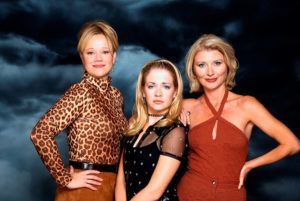
Hilda, Zelda and Sabrina from Sabrina the Teenage Witch.
Sabrina, in the sitcom, I found to be very brave and thoughtful. The moment she found out she was a witch, she used her magic for her friends and yes, sometimes her uses could be selfish. However, all of her uses of her magic, no matter what it was used for, came from the heart. Especially when it came to Harvey, who as you may know is her soulmate. Despite him being her boyfriend throughout the series, it never stopped Sabrina from pursuing her dream. Sabrina had also always been passionate about her studies and succeeding. This is part of the reason why I have always loved her as a character.
Salem takes the cake though. He is a comedic gift from the Gods. I mean it when I say Salem is the best character on the show. As most of you probably know, Salem is their family cat and has been with Hilda and Zelda for years. Salem is their familiar, but Salem has a backstory which is undeniably hilarious. Salem was originally a witch, but after attempting world domination, he was sentenced to hundreds of years of being a cat. Despite him being a cat, that doesn’t stop him from causing tons of shenanigans throughout the series. This just gives him more character.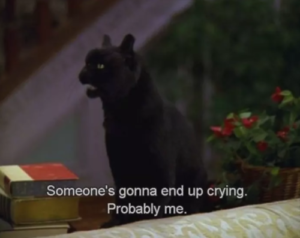
Salem from Sabrina the Teenage Witch.
Yes, it may be goofy and yes, it may not be gritty, but it’s lighthearted. Sometimes, you just need a little laugh.
Now that I have clearly state my love for the 90s sitcom, I should state my thoughts on the Chilling Adventures of Sabrina.
Now, in this series being a witch is no surprise for Sabrina unlike in the Sitcom. She has known she was a witch since she was little and in this series, her parents have passed leaving Hilda and Zelda (including her cousin Ambrose, who was not in the sitcom) to take care of her. In the sitcom, Sabrina isn’t allowed contact with her mortal mother or her mother will be turned into a ball of wax. Her father, in the sitcom, was out traveling and working. The way they approached her parents in the Netflix series was just rather bleak.
Salem the cat in the new series, does not talk. He also does not have his awesome backstory not to mention that Sabrina attains Salem by summoning her own familiar. I would have nothing against this way of approaching introducing Salem. In fact, it is more or less that I’m angry that Salem doesn’t talk. He doesn’t bring anything to the table in the new series. Salem, in fact, is hardly shown in the show despite him being very important in the sitcom version.
Salem from Sabrina the Teenage Witch.
You may say that it’s petty of me to be upset about a cat, but Salem is apart of the Spellman family, so to not include him in the new series seems ridiculous to me.Now, let’s talk about Harvey. This is something that I hold a lot of thoughts on. In the sitcom Harvey is a doof. He’s goofy and somehow never found out that Sabrina was a witch for years. Netflix must’ve upped Harvey’s IQ because he does not skip a beat in the new series. Not to mention the fact that despite Harvey being Sabrina’s boyfriend, he was always sort of a side character.
In the Netflix series, you are introduced to Harvey’s family. Of course, you’ve had some backstory for Harvey in the sitcom. You knew his parents were together, he had sibling and his dad worked as an exterminator. In the Netflix series, Harvey has a brother and a dad, and his dad works in a mine. His dad, in the Netflix series, is rather aggressive and abusive, which was never established in the sitcom.
My final comparison about Harvey comes to his reaction to when he finds out that Sabrina is a witch. In both series Harvey is clearly did not handle Sabrina being a witch very well. In the sitcom Harvey ends up breaking up with Sabrina for a very short moment. Towards the end of the series, Harvey ends up patching up things with Sabrina. In fact, they end up becoming very good friends like they did in the beginning of the sitcom. In the Netflix series, Harvey wants to end all ties with her. He acted like being a witch was the equivalent of being a monster. In fact, even when Sabrina tries to patch things up and help Harvey, he still treats her like a monster.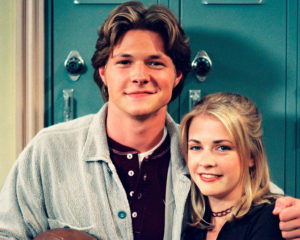
Harvey and Sabrina from Sabrina the Teenage Witch.
This leaves me to my final thoughts. I would like to end this post talking about how the two series deal with the topic of witches. In the sitcom, they treated witches differently than in the Netflix series. In Sabrina the Teenage Witch, all the witches lived harmoniously. They had their own government, The Witches Council, and lived in what they called the Other Realm. However, some witches chose to live in the mortal realm, which is earth.
In the Chilling Adventures of Sabrina, they use cliche witch backgrounds. They make them seem quite evil when they really are not. Of course I am not saying there aren’t any witch stereotypes in the sitcom. In the sitcom, they have their familiars and also make potions in cauldrons, however, those do not compare to the stereotypes portrayed in the Chilling Adventures of Sabrina. In the Chilling Adventures of Sabrina, they portray witches like every media platform does. This bothered me the most.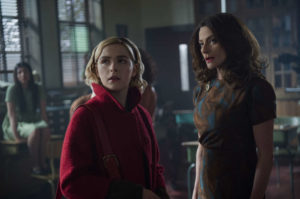
From the Chilling Adventures of Sabrina
I love the sitcom because it is not full of stereotypes. It doesn’t make witches out to be Satan loving monsters. Not all witches, in my opinion, are Satan loving monsters. I understand they wanted to make a gritty remake, but what made the sitcom so original to me was how lighthearted it was, even if they did touch up on difficult topics.
The way Netflix portrayed witches to me was something that I’ve seen so many times before. Making witches Satan worshippers is so. . .overused and not at all true. Today, there are people who identify as witches who do not worship Satan. I find the use to having a “dark baptism” and celebrating their “lord Satan” in the Netflix series is stereotyping and frankly, rude.
From the Chilling Adventures of Sabrina
I’m not saying the Netflix series is all bad. There are aspects of the show that are enjoyable. However, it was not my favorite. I found there to be a lot of things I did not enjoy. Not to mention, there are things I would definitely tweak, but overall, the editing was well done and I believe it was well produced. Although, I’d take a goofy talking cat in a silly sitcom any day.Lou is a writer of rom coms, eater of pizza, lover of 90s boybands and cat enthusiast. You can follow her on Twitter at @aweosmewriter.
November 9, 2018
Tim Cooper’s The Reader: War For The Oaks
Front cover
This is my first review for The Green Man Review, but I cannot help but feel I have somehow come full circle from the moment in a 2005 World Fantasy Convention bar when someone kept telling me how much they enjoyed my Green Man Review reviews and I kept mentioning they had the wrong Cat. Now all I can do is assume they traveled in time somehow. And so. Let’s look at a nifty book in the here and now, in what is hopefully the first of many reviews.The Reader: War For The Oaks is a hardbound book presenting a photography project by Tim Cooper. It’s a slim little 8.5″x 11″ volume, clocking in at 96 pages. The pleasant interior design presents the photos nicely, along with some pretty arboreal details. The cover, whose design is unobjectionable but unremarkable, features a photo that lets the reader know exactly what the book is about: photos of people reading War For the Oaks in various Minneapolis locations.
There are a few books I have re-read so many times that they are an integral part of fantasy to me, and Emma Bull’s first novel, War for the Oaks is one of them, featuring Eddi McCandrey and her half-human, half-elvish band, the Fey. It was originally published in 1987; the paperback copy I’ve been carrying around for decades is battered and coverless now, but it was a pleasure to have the task of going back and reading it yet again in order to do this review.
I’m not alone in loving this story, and the book’s part in defining and shaping urban fantasy cannot be overestimated. Reading in many ways like a crisper, less Romantic version of Charles de Lint, Bull demonstrates in this book that despite being one of the quieter writers, she will become a major talent. Many nifty but commercially non-viable projects that we would miss if reliant only on traditional publishing have come out in recent years, often supported through crowdfunding; this one was a Kickstarter project. It’s delightful to see a project dedicated to the novel in this way, celebrating how much the book has meant to many readers.
Which is perhaps my major caveat. This book will enchant, down to their very toes and beyond, those who love Bull’s novel and know the city as well. Cooper’s photos show locations from the book in an order corresponding to the novel’s chronology, each time with people reading War for the Oaks somewhere in the picture. For someone who loves the book in part because of its setting, the sole disappointment may be that the photo are low enough resolution that sometimes it is difficult to make everything out.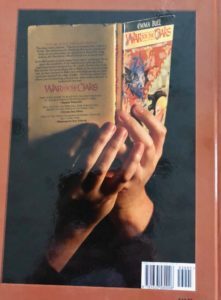
Back cover
Familiar with the book but not so much with the city? Mileage will vary here, depending both on one’s degree of affection for the book as well as how firmly the reader is attached to their vision of things. Someone with a mental vision that is particularly strong, in fact, might find it jarring to have it contradicted by these pictures.
Familiar only with the city? Here again mileage will vary radically depending on factors like how interested one is in examples of projects like this or if one is a book collector specializing in fantasy and science fiction (in which case, you’ve probably had the novel on your list but just never got around to it). Lovely extra details scatter themselves here and there throughout the book, as well as photos featuring other authors like Elizabeth Bear, Stephen Brust, PamelaDean, Marissa Lingen, Scott Lynch, and Patricia C. Wrede. Essays by Dean, Sigrid Ellis, Sarah Olsen and Katherine St. Asaph appear at the back, along with a poem by Alec Austin.
Familiar only with the city? Here again mileage will vary radically depending on factors like how interested one is in examples of projects like this or if one is a book collector specializing in fantasy and science fiction (in which case, you’ve probably had the novel on your list but just never got around to it). Lovely extra details scatter themselves here and there throughout the book, as well as photos featuring other authors like Elizabeth Bear, Stephen Brust, PamelaDean, Marissa Lingen, Scott Lynch, and Patricia C. Wrede. Essays by Dean, Sigrid Ellis, Sarah Olsen and Katherine St. Asaph appear at the back, along with a poem by Alec Austin.
I’ve stuck this on one of my shelves of favorite F&SF next to that battered paperback copy of War for the Oaks, because it’s definitely a keeper. Next time I’m at a con with the author, I may even take it along, because having it signed by the person whose book inspired so much passion would make it even niftier.
(Tired Tapir Press, 2014)
You can read this review at http://thegreenmanreview.com/books/recent-reading-eddi-and-the-feys-revival-tour/
November 2, 2018
Michael DeLuca’s Reckoning 2: Creative Writing on Environmental Justice
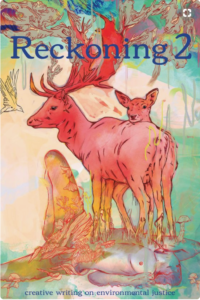 Reckoning 2: Creative Writing on Environmental Justice is solid in weight and content. The stories, poetry, essays, and art deal with the world around us and our ethics in dealing with it. This refined focus sharpens the magazine’s impact, I think, and makes it something that tries to evoke change through its art rather than the shallow comfort afforded by something whose theme was simply “Nature”.
Reckoning 2: Creative Writing on Environmental Justice is solid in weight and content. The stories, poetry, essays, and art deal with the world around us and our ethics in dealing with it. This refined focus sharpens the magazine’s impact, I think, and makes it something that tries to evoke change through its art rather than the shallow comfort afforded by something whose theme was simply “Nature”.
The annual’s mission statement is A locus for the conflict between the world as it has become and the world as we wanted it to be. Editor Michael DeLuca’s opening editor’s note, “On Having a Kid in the Climate Apocalypse,” deals with a life situation that makes that mission even more pressing: having a kid:
My son is three months old. He has no idea what the world is, what it has become. I can say anything in front of him. I can curse. I can cry. He’s happy or he’s sad. there’s no cause and effect. I can read to him from A Tree Grows in Brooklyn, a book that spends hundreds of pages drawing an analogy between a child growing up and an invasive tree species flourishing in a sidewalk crack, a book full of compassion for the poor hated by the rich, casual about the hatred it portrays for people of other cultures. He doesn’t understand a word.
The essay is intimate, frank, and willing to comtemplate its own imperfections:
Maybe this revelation isn’t for everyone. Maybe not everyone needs it. Maybe, to people who aren’t white, aren’t straight, aren’t privileged children of educated families, some of this is so painfully obvious. I’ve spent this essay embarrassing myself. I needed it. I needed to write it. I needed my assumptions undermined and broken up and reassembled around someone who wasn’t me.
While there are several essays in the magazine, all of them nicely put together and executed, my favorite pieces from the issue are all stories:
“Wispy Chastening” by D.A. Xiaolin Spires is slight but significant, much like the narrator’s crimes against the environment, turning this into a sharp look at the idea of thinking globally but acting locally, or even individually.
“To the Place of Skulls” by Innocent Ilo provides an Afrofuturist post-apocalyptic world where its protagonists visit a landscape of grit and myth:
We are going to the Place of Skulls: Saro-Wiwa, Babbe, Gokana, Ken, Nyo, Ueme, Tai, and myself. For you to know, this is not the place Bro Lucas said Jesus was crucified when he was spitting into my face from the broken lectern during his sermon, last Sunday. The Place of Skulls is where a stark reality stares us in the face. We all have after-school exhaustion, Babbe’s diarrhea has worsened, Gokana is still nursing the burns on his legs from our last visit and Mama will yank at my ear if she hears fim about it, but we must go. The Place of Skulls is that important.
“Girl Singing with Farm” by Kathrin Köhler broke my heart and yet I know I’ll go back and read it several more times. What seems like it may be simplistic turns into a beautiful, layered story with a final image that will linger with the reader.
I’m saving the best for last and that is the story “Fourth-Dimensional Tessellations of the American College Graduate” by Marie Vibbert. I love this story so much that I am not going to discuss a single detail except that the ending made my heart leap and it is my favorite story of 2018 so far. I will hold onto my copy of this magazine forever because it contains it.
Highly recommended for those enjoying more literary SF as well as thoughtful essays.
(Reckoning Press, 2017)
You can read this review at http://thegreenmanreview.com/books/recent-reading-reckoning-2/
October 26, 2018
Catherynne M. Valente’s Space Opera
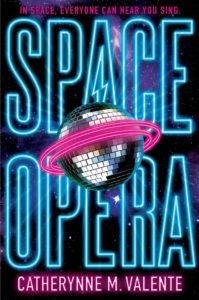 It is difficult to describe how Catherynne M. Valente’s new book Space Opera manages to be so wonderfully resonant of Douglas Adams’ The Hitchhiker’s Guide to the Galaxy yet so insistently, inimitably her own. And yet, that’s the challenge.
It is difficult to describe how Catherynne M. Valente’s new book Space Opera manages to be so wonderfully resonant of Douglas Adams’ The Hitchhiker’s Guide to the Galaxy yet so insistently, inimitably her own. And yet, that’s the challenge.
Valente’s skill manifests in a book that bounces right along, full of glorious, funny, wonderful, sparkly explosions of humor and wit that still, just as Adams always did, manages to say Insightful and Interesting Things about Human Nature. And it’s funny. Did I mention that this is a funny book? It’s the story of failing rock singer Decibel Jones and his dysfunctional band, the Absolute Zeroes, who have been chosen to represent their world in an interstellar challenge that determines whether or not the Earth will be destroyed.
But it’s more than an updated Adams. It’s a little deeper and a lot better about things like gender pronouns and interestingly diverse cast. It has much more fashion and quirky stylistic details than HHGG, with fabulous living starships that resemble coral reefs, so much music of so many kinds, and enough eyeball kicks on every page that one fears sometimes for the safety of one’s figurative vision.
The first two chapters are admittedly slow going. The book doesn’t really find its legs until a bit into chapter three, after we’ve finally been introduced to protagonist Jones “lying passed out on the floor of his flat in a vintage bronze-black McQueen bodysuit surrounded by kebab wrappers, four hundred copies of his last solo album, Auto-Erotic Transubstantiation, bought back from the studio for pennies on the pound, and half empty bottles of rosé.”
At this point the alien invasion that’s been textually hovering in the wings for a while hears its cue and manifests:
…in everyone’s rooms at once at two in the afternoon on a Thursday in late April. One minute the entire planet was planet-ing along, making the best of things, frying eggs or watching Countdown or playing repetitive endorphin-slurping games or whatnot on various devices, and the next there was a seven-foot-tall ultramarine half-flamingo, half-anglerfish thing standing awkwardly on the good rug. Crystal-crusted bones showed through its feathery chest, and a wet, gelatinous jade flower wobbled on its head like an old woman headed off to church. It stared at every person in the world, intimately and individually out of big, dark, fringed eyes sparkling with points of pale light, eyes as full of unnameable yearning and vulnerability as any Disney princess’s.
This passage demonstrates the clean virtuosity of Valente’s prose in Space Opera. I’ve loved her other works, particularly The Orphan’s Tales, but this is a very different style for her and it’s truly impressive to see her execute it with the same seemingly effortless grace. Omniscient point of view is handled beautifully, and shows how well suited it is to large scale works like this one.
Space Opera will delight Valente’s fans and undoubtedly bring a new crowd her way, because it’s just plain good and funny and wonderful. I can’t imagine what Valente will pick for her next project. At this point I’m convinced she could make a set of instructions for assembling an IKEA dresser beautiful and engrossing. And I’m looking forward to that read.
(Saga Press, 2018; available April 3)
You can read review at http://thegreenmanreview.com/books/catherynne-m-valentes-space-opera/
October 24, 2018
Recent New Processes and the Results: How I’m Managing 5k Words a Day
 I came back from PNWA this year inspired by talking to Chris Fox, author of 5,000 Words an Hour, and adopted a new writing process, which has several parts. I want to emphasize that I’m pretty sure this is not a process that’s going to work for everyone. I have, for example, major luxuries such as a) no children, b) the financial resources for a gym membership, c) the time to make use of that membership as well as devoting a significant chunk of my time to writing, and d) good health and reasonably good energy levels. If this process sounds like one that might work for you though, I highly suggest you check out both the book as well as others by Chris Fox.
I came back from PNWA this year inspired by talking to Chris Fox, author of 5,000 Words an Hour, and adopted a new writing process, which has several parts. I want to emphasize that I’m pretty sure this is not a process that’s going to work for everyone. I have, for example, major luxuries such as a) no children, b) the financial resources for a gym membership, c) the time to make use of that membership as well as devoting a significant chunk of my time to writing, and d) good health and reasonably good energy levels. If this process sounds like one that might work for you though, I highly suggest you check out both the book as well as others by Chris Fox.
So here’s what I do.
I get up at 5:30 AM and drive over to the gym to work out, doing a mix of elliptical and rowing machine, mainly about 45 minutes to an hour’s worth. In recent days, when the fog has been thick, I’ve chosen to do an hour’s brisk walk instead. Yes, it is dark, and cold, and miserable. No, I am not looking forward to colder weather and having to de-ice things.
I come back here, eat my yogurt, start a pot of coffee, and begin writing with absolutely no Internet allowed, whether on phone or computer.
I write in Scrivener, (writing software I’ve been using for over a decade now, available for both Mac and Windows OS) and I set myself a goal of 5,000 words, keeping the word count tracking window open so I can see the progress.
I do a lot of 30 minute writing sprints, where I spend a few minutes beforehand figuring out what I want to accomplish in the scene I’ll be writing. Some of that will be typed, but if the flow is going well, I may switch over to dictation, using the Mac’s dictation feature, which I’ve come to favor over Dragon Dictate.
Usually by 9 or 9:30 AM I hit the 3k word mark, and at that point, let myself walk over to a local coffee shop to pick up a latte and a pastry. It’s a 10 minute walk (and that’s another luxury I have, pleasant and safe surroundings for such a walk.) I can text my spouse at this point, but no Internet access still, even when waiting in line at the coffee shop.
Sometimes I’m not sure I’ll hit my 5k mark by 11 AM but most of the time I do. (If I don’t, I keep writing till I do.)
I reward myself for hitting my goals, usually with something on a weekly basis, but I’ve also been known to promise myself a treat for the day if it’s hard going. The rewards of late are Breyer horses, which is something that I would normally never allow myself to splurge on. Apparently my inner twelve-year-old is a powerful motivator.

The Breyer that started it all, “The Girl from Ipanema” form th Equestral line.
Doing this has pretty consistently yielded 5,000 words each weekday along with another 5,000 spread out over the weekend, with the experience of the past few days, when I was at a writing conference but still managed two early morning workouts and 2,000 words. Currently I’m at over 93,000 words for the month of October. I’ve finished two books since PNWA: an adult novel as well as a middle grade one, and am currently 22,000 words into the sequel to the former.I’m more productive overall and less likely to put stuff off (I think). Chris quotes Mark Twain as saying “Eat a live frog first thing in the morning and nothing worse will happen to you the rest of the day.” And it’s true. Get it and soldier through something not particularly palatable, and other stuff becomes easier. It does seem that, for me, working on strengthening my willpower is paying off. Staying off the internet is better overall for my sanity I think; I know I’ve pretty much stopped paying any attention to the trollios because there’s just not enough time in the day and wrangling with them is pointless anyhow.
And what I’m writing is pretty good! Writing that fast means it’s fresher in my head and I’m less likely to lose my way or forget bits I’ve added, The “making it all fit together pass” is easier than with manuscripts written over more time.
So why say all this? Am I taunting you with my productivity? Absolutely not. But I am saying – I started pushing myself a little harder and I was surprised how much farther I could go by doing something that put me in my body and then avoiding distractions and focusing on writing in an undiluted way, free of email distraction. There was no mail so important it could not wait until 11 AM.
I did learn to get better about getting set up ahead of time, making sure my gym clothes were laid out, my headphones ready, and that I knew where Wayne had parked the car each night. One morning I ended up going to the gym in damp clothes and feeling quite virtuous; I’ve also been feeling a lot healthier, stronger, and more energetic as a result of this regime.
I also don’t beat myself up if I miss track. I didn’t write as much as I wanted to at Surrey, but I also spent some time napping and reading in order to maintain my energy level and stay at my best during the conference. Today it was so foggy that I didn’t drive over to the gym — but I still managed to get my 5k in, so hooray for me. Tomorrow will be another day.


